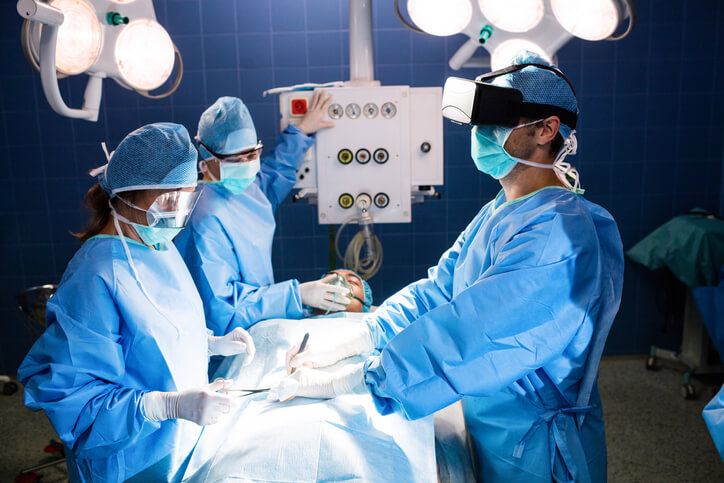Digital operating rooms
Operation rooms are increasingly becoming fully digitized worldwide. However, was it always that way? Decades ago, operation rooms suffered from near-misses or accidental deaths due to the fundamentals; poor planning, communication problems, and the inability to perform certain operations as no tool or technology even existed.
The tide has shifted. As technologies emerge, so do their application to the medical sector, especially the operating room. No form of technology is exempt from the operating theatre. From virtual reality and augmented reality to advanced robotics and Artificial Intelligence, startups and established corporations have managed to mark their territory using one or more of these technologies. Digital transformation in the operation rooms has huge benefits.
Surgeons can now perform faster procedures with fewer errors. Nurses, administrators, and even patients have a wealth of data being sent to them by innovative and intuitive software. With that information, support teams can plan surgeries more efficiently, reducing wastage and decreasing costs.
Patients can be more informed about what’s happening and feel more assured. The operating room equipment market is rising too. According to a 2017 Market Research report, the market size was valued at 26.4 billion USD in 2016 and expected to grow at least 7.2% in the next ten years.

Image courtesy of Grand View Research
Surgical imaging, patient monitoring, and electrosurgical devices fall under the matrix of digital solutions, and they expect market growth as well. As the demand grows, some recent startups and long-standing medical equipment players alike have taken up the challenge of solving some of the operating room’s most profound problems using the latest technology.
Top players developing digital solutions for operating rooms
1. Explorer Surgical
With several moving parts in a successful operation, it is essential for teams to be in sync. With innovative software, Explorer Surgical sets out to do just that by streamlining processes for nurses, surgeons, and administrators.
Imagine an operating room where everyone knows what their roles are and what the next steps are on real-time screens and tablets. Teams can also see what the preferences of the surgeons and anesthesiologists are and set the environment to suit, without waste.
This allows for increased efficiency, higher accountability, and happier patients. Using data analytics, it can send data back to the administrators to track costs and make adjustments for future procedures. Explorer surgical understands operating theatres share the bulk of a hospital’s operating costs and intend to save teams both time and money.
2. GoSurgery
London based startup Digital Surgery believes in safe surgeries for all. The company has successfully launched an Artificial Intelligence platform called GoSurgery for the Operating Theatre. It uses cameras and checks the actions of surgeons against an evolving library of surgeries, roadmaps and philosophies.
It can then map the best course of action for the surgeon and provide next-step support and recommendations. This vast library of information allows Operating Theatre teams to reduce waste, improve success rates, improve safety, and the overall performance of OR teams.
3. Smart Needle
Can brain surgery be safer and more successful? A research team at The University of Adelaide says yes. Brain biopsies are one of the riskiest procedures and causing irreparable damage to blood vessels during the operation is a possibility. Together with the Sir Charles Gairdner Hospital, the team has developed the ‘smart needle.’
A fibre-optic camera is attached to the biopsy needle. It shines an infrared light to alert the surgeon of nearby blood vessels, preventing possible ruptures. The technology has already been tested on 12 patients in 2017 and will be clinically tested during 2018. Its success will bring improved confidence and success rates to one of the most delicate operating procedures around.
4. Auris Health
This innovative startup uses flexible robots to perform non-invasive procedures to gather data on patients. Calling its technology, ‘The Monarch Think of a long, snake-like device with a powerful camera at the head. Using a device similar to a video game controller, a surgeon can navigate the robot, collect data and perform small procedures with minimal invasion needed.
It’s starting by mainly targeting lung cancer by allowing surgeons to target areas of the lung that were almost impossible to reach and perform the necessary treatment to save lives.
5. Synaptive Medical
While Auris looks at small robots, Synaptive Medical provides a robot that’s bigger but not intrusive in any way. For example, The Modulus V Robotic Digital Microscope is a hands-free microscope that can follow the movements of the surgeon as he performs, giving him a view at angles that was difficult to achieve before.
It has proven to be instrumental in complicated brain surgeries giving surgeons confidence and more precise data so improved decisions can be made.
Synaptive provides a wide range of digital solutions for the OR from visual representations of the brain to Big Data to help teams make changes to surgical procedures on the fly.
6. Augmedics
Imagine the delicate procedure of spinal surgery aided by the ability to focus directly on the patient, seeing their anatomy through an augmented Image. The current standard is to look away from the patient’s body, using a screen connected to IR cameras to guide them while operating. It’s easy to see how one misstep can cause a grave error.
Using NVIDIA technology, an accurate Infrared tracker and Augmented Reality (AR) glasses, the XVision Head Mounted Display by Augmedics wants to bring efficiency and accuracy to intensive procedures like that of the spine. It feeds the surgeon data, allowing him/her to see where their instruments are and gives them real-time information to find the best and safest route to perform spinal surgery.
7. Osso VR
The digital solutions making operation theatres more successful sometimes happen outside of the theatre. Surgeons in training get to practice procedures on real bodies maybe once or twice. They then have notes and images to help them study for exams. The next time they may have to perform the same surgery physically? It could be in a real-life scenario.
Using VR technology to simulate surgeries and surgery techniques, the Startup Osso VR is looking to bring confidence and improved accuracy in the Operating Theatre through improved training practices. Simulated environments can produce higher performing, confident doctors and can reduce amateur errors.
Operating rooms of the next generation
It’s natural that digital solutions have found its way into the global medical sector. Doctors appreciate the confidence, efficiency, and efficacy that digital solutions bring to the operating theatres. Nurses can support their teams and respond to emergencies quicker with a wealth of information at their fingertips.
Patients and their families can be assured that the best minds in and out of the rooms working to create higher success rates, and lower recovery times.
Technologies such as VR, AR, Robotics and AI will become more accessible in Operating theaters around the world as the costs to produce them decrease. Until then, with companies new and old pushing the envelope, we can be assured that the Operating theater is in good technological hands.
Image credit: www.istockphoto.com

















